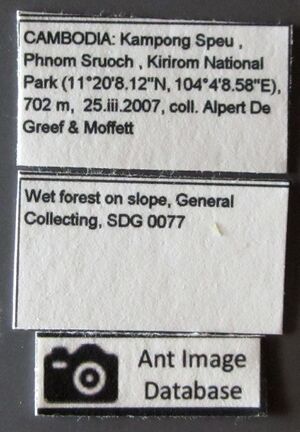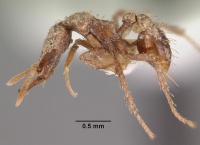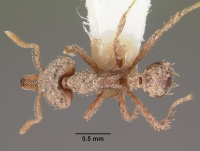Strumigenys tritomea
| Strumigenys tritomea | |
|---|---|

| |
| Scientific classification | |
| Kingdom: | Animalia |
| Phylum: | Arthropoda |
| Class: | Insecta |
| Order: | Hymenoptera |
| Family: | Formicidae |
| Subfamily: | Myrmicinae |
| Tribe: | Attini |
| Genus: | Strumigenys |
| Species: | S. tritomea |
| Binomial name | |
| Strumigenys tritomea Bolton, 2000 | |
Nothing is known about the biology of Strumigenys tritomea.
Identification
Bolton (2000) - A member of the Strumigenys chapmani-group. S. tritomea is unique in the group by its possession of a cuticular lamella on the inner margin of the mandible.
Keys including this Species
Distribution
Distribution based on Regional Taxon Lists
Oriental Region: Cambodia, Thailand (type locality).
Distribution based on AntMaps
Distribution based on AntWeb specimens
Check data from AntWeb
Countries Occupied
| Number of countries occupied by this species based on AntWiki Regional Taxon Lists. In general, fewer countries occupied indicates a narrower range, while more countries indicates a more widespread species. |

|
Estimated Abundance
| Relative abundance based on number of AntMaps records per species (this species within the purple bar). Fewer records (to the left) indicates a less abundant/encountered species while more records (to the right) indicates more abundant/encountered species. |

|
Biology
Castes
   
| |
| . | Owned by Museum of Comparative Zoology. |
Nomenclature
The following information is derived from Barry Bolton's Online Catalogue of the Ants of the World.
- tritomea. Strumigenys tritomea Bolton, 2000: 770 (w.) THAILAND.
Unless otherwise noted the text for the remainder of this section is reported from the publication that includes the original description.
Description
Worker
Holotype. TL 3.0, HL 0. 86, HW 0.73, CI 85, ML 0.32, MI 37, SL 0.38, SI 52, PW 0.33, AL 0.83. Mandible broad and flattened, inner margin with a straight-edged cuticular lamella that extends from base almost to apicodorsal tooth; inner edges of lamellae almost meet when mandibles fully closed. Apicodorsal tooth long and spiniform, subtended by two shorter spiniform teeth, the apicoventral of which is slightly longer than the apicomedian; these two teeth slightly rolled under the apicodorsal, not directly ventral to it. Space between apicomedian and apicoventral tooth with 1, or possibly 2, small intercalary teeth (difficult to see clearly in specimens available). Ventrolateral margin of head shallowly concave immediately in front of eye. Ventral surface of head with a broad shallow impression behind level of eyes. Dorsal surfaces of head and alitrunk densely reticulate-punctate (obscured by film of dirt in holotype). Pleurae and side of propodeum not reticulate-punctate. Petiole node reticulate-punctate; disc of postpetiole mostly smooth. Basigastral costulae shorter than length of postpetiole disc. Cephalic dorsum with a few short standing hairs along occipital margin, otherwise dorsum only with short spatulate ground-pilosity. Upper scrobe margin fringed with anteriorly curved short spatulate hairs and with a longer stouter apicoscrobal hair. Dorsal surfaces of promesonotum, waist segments and first gastral tergite with curved standing hairs that are stout and thickened to remiform apically; those on gaster longer than those on promesonotum but the latter somewhat more expanded apically. Long hairs that project from dorsal (outer) surface of hind basitarsus stiff stout and slightly curved, not flagellate.
Paratype. TL 3.0, HL 0.85, HW 0.71, CI 84, ML 0.33, MI 39, SL 0.38, SI 53, PW 0.33, AL 0.80.
Type Material
Holotype worker, Thailand: Wab Pang An, 3.xi.1985, 900 m., no. 3 (Lobl & Burckhardt) (Musee d'Histoire Naturelle Genève).
Paratype. 1 worker with same data as holotype (The Natural History Museum).
References
- Bolton, B. 2000. The ant tribe Dacetini. Memoirs of the American Entomological Institute. 65:1-1028. (page 770, worker described)
- Khachonpisitsak, S., Yamane, S., Sriwichai, P., Jaitrong, W. 2020. An updated checklist of the ants of Thailand (Hymenoptera, Formicidae). ZooKeys 998, 1–182 (doi:10.3897/zookeys.998.54902).
- Tang, K. L., Guénard, B. 2023. Further additions to the knowledge of Strumigenys (Formicidae: Myrmicinae) within South East Asia, with the descriptions of 20 new species. European Journal of Taxonomy 907, 1–144 (doi:10.5852/ejt.2023.907.2327).
References based on Global Ant Biodiversity Informatics
- Bolton, B. 2000. The Ant Tribe Dacetini. Memoirs of the American Entomological Institute 65
- Fontanilla A. M., A. Nakamura, Z. Xu, M. Cao, R. L. Kitching, Y. Tang, and C. J. Burwell. 2019. Taxonomic and functional ant diversity along tropical, subtropical, and subalpine elevational transects in southwest China. Insects 10, 128; doi:10.3390/insects10050128

